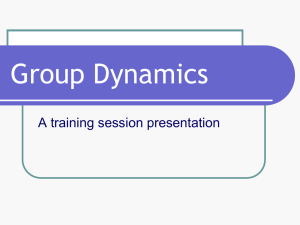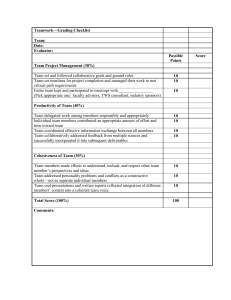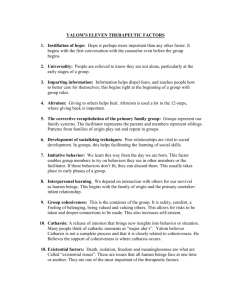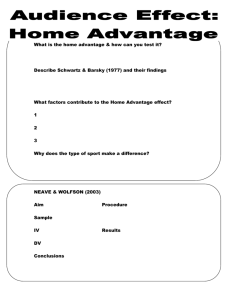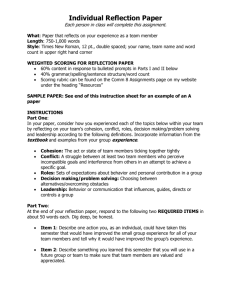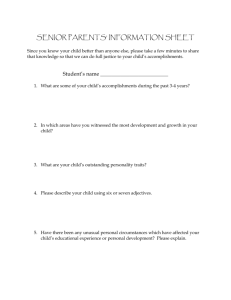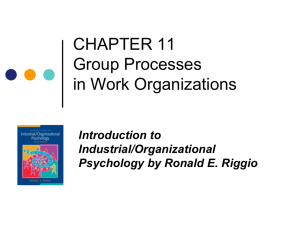national standards for athletic coaches - Cal State LA
advertisement
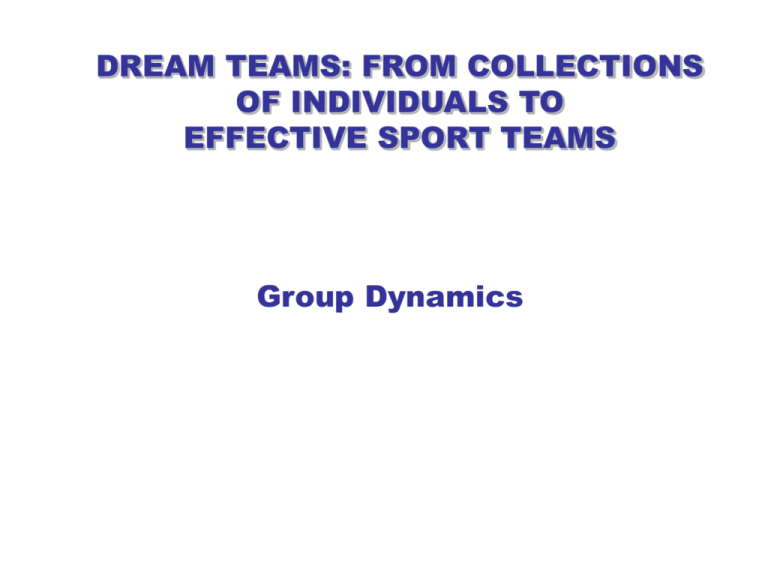
DREAM TEAMS: FROM COLLECTIONS OF INDIVIDUALS TO EFFECTIVE SPORT TEAMS Group Dynamics Group/Team Dynamics • Anyone traveling around the world and observing different people can readily notice that human beings spend a great amount of time doing things together in groups. German sociologist, Kurt Lewin coined the term "group dynamics" and created fertile grounds for new ideas such as "group culture" and "group mind." Anthropomorphic Characteristics of Teams • Do terms like "group mind," or "team spirit" make any sense when examined through a Newtonian perspective of reality? • Can the extent of the team's spirit be somehow measured? • Is a team's performance a reflection of the added individual talents of its individual members or is a team's performance a reflection of a sum that is greater, or smaller than, the tally of each of the individual performances? Sir Isaac Newton Given the fact that one has all the necessary information, according to Newtonian physics, it is possible, in principle, to predict exactly how a given event is going to unfold. Anthropomorphic Characteristics of Teams • Subatomic particles cannot be pictured as an object, rather they can be viewed as "tendencies to exist" or "tendencies to happen." Experiments in the subatomic realm demonstrate that there is no way to predict individual events at that level. Therefore, quantum mechanics concerns itself only with group behavior (example of billiard balls vs. subatomic particles). Anthropomorphic Characteristics of Teams • Psychologists William McDougal and Floyd Allport led two opposing views regarding the "group mind" controversy (Gergen, 1982). F.H. Allport was a harsh critic of the anthropomorphic conception of human groups. In his view only individuals were real and groups or institutions were "sets of ideals, thoughts, and habits repeated in each individual mind and existing only in those minds (Allport, 1924)." (billboard balls example). Anthropomorphic Characteristics of Teams •McDougal, on the other hand, held the position that groups, institutions, and culture formed new realities and forces that could not be explained by strictly adding the particular individual group members' talents and contributions. McDougal's view is analogous to the relationships between subatomic particles which mix and merge with the neighboring particles and create new relationships. Characteristics of Teams • Floyd Allport's individualistic orientation was the dominating view in academia until Mayo (1933) and his associates reported their extensive research at the Hawthorn plant of the Western Electric Company. What started as a project to investigate the relation between conditions of work and the incidence of fatigue among workers ended up changing radically and irrevocably the thinking about industrial worker dynamics. Characteristics of Teams • "The role of the leader began to shift from one who directed work to one who enlisted cooperation. The incentive to work was no longer seen as simple and unitary but rather infinitely varied, complex, and changing (Haire, 1954)." Characteristics of Teams • Sports, as most sport scientists would agree, is a microcosm of society--it mirrors the values, structure, and dynamics of the society in which it exists (Coakly, 1994). It is no wonder, therefore, that the concept "group mind" was eventually investigated in the realm of sports and sports teams. Social Entities Called “Group” • Different groups, as well as sport teams, display a great variety of properties such as size, duration, objectives, internal structures, norms and many other aspects. The large variety of properties displayed was the main reason for the difficulty in the formulation of an all encompassing definition of the term "group." “Group” Defined • Homans (1950) "A group is defined by the interaction of its members." • Lewin's (1948) a group is best defined as "...a dynamic whole based on interdependence rather than on similarity." • Bass (1960) defined 'group' as "...a collection of individuals whose existence as a collection is rewarding to the individuals." It does not take a sport sociologist to see how each of the above mentioned definitions of 'group' describe some aspects of a sport team. Cohesiveness and “Group Dynamics" • Kurt Lewin (1935) coined the term "cohesiveness” in (Cartwright & Zander, 1968) and the term "group dynamics." The relationship between social cohesion, group dynamics and sport team participation and performance will be examined. Athletes coaches and researchers alike often assumed that when players on a team display unity and "stick together," they will have a greater chance of team success. Some Research on Cohesion Positive Relationship Negative Relationship • Arnold & Straub, 1972 • Ball & Carron, 1976 • Carron & Chelladurai 1981 • Gosset & Widmeyer, 1981 • Widmeyer & Martens, 1978 • Melnick & Chembers, 1974 • Ruder & Gill, 1981 NO Relationship • Landers & Lueschen, 1974 • Martens & Peterson, 1971 Developing the Sport Team Concept • • • • (1) proximity (2) distinctiveness (3) similarity (4) group goals and rewards (personal vs. group). Group Structure • Group roles: Formal vs. Informal –role clarity, role acceptance, and role performance Establishment of Group Norms • norm for productivity –"rate busting" and "malingering" –stability of group norms (Jacobs & Campbell, 1961) Stabilizing Group Structure • Show individual team members how the group's standards can contribute to the achievement of desirable qualities for the team, more effective team performance, and a greater sense of team unity. Zander (1982, cited in Carron, 1986, p. 82) Stabilizing Group Structure • Point out to all team members how their contribution toward developing and maintaining the standards can contribute to the team's success. • Develop a method of assessing whether there is adherence to the group's standards, and then reward those team members who do adhere and sanction those who do not. Remember: Group members adhere best to those decisions in which they have had input. Zigon Appraisal of Group/Team Performance Performance elements are evaluated by using a minimum of three levels, with a broadly defined fully successful standard. http://www.opm.gov/perform/articles/024.htm How to Measure the Results of Work Teams Performance below the standard is considered unacceptable, and performance exceeding the standard is considered exceptional. http://www.opm.gov/perform/articles/024.htm Zigon’s Seven-Step Process for creating performance standards for teams (1-2) (1) Review existing organizational measures. Ensure that the measures above and around the team are known and linked to the team's measures. (2) Define what's going to be measured. Zigon offers four alternatives for identifying what the team needs to measure. He comments that selecting the best alternatives and using them to identify the team's key accomplishments provide the basis for all further measurement. Zigon’s Seven-Step Process for creating performance standards for teams (3-4) (3) Identify individual team member accomplishments that support the team. Identify the results each team member must produce to support the team's results or work processes. (4) Weight the accomplishments. Discuss and agree upon the relative importance of each accomplishment. Zigon’s Seven-Step Process for creating performance standards for teams (5-7) (5) Develop team and individual performance measures. Identify the measurement (either numeric or descriptive) that will be used to gauge how well the results have been achieved. (6) Develop team and individual performance standards. Define how well the team and individuals have to perform to meet expectations. (7) Decide how to track performance. Identify how the data for each performance standard will be collected and fed back to team members. Discussion (methods 1-3) • The first three methods of identifying measurement points listed above focus on measuring accomplishments. (Even the fourth method, which focuses on work process, looks at the results of work at critical places in the process.) Zigon defines work results as accomplishments end products, not activities. Accomplishments are what is left behind when you go home; they take the form of nouns, not verbs. Properties Associated with Cohesiveness • Attraction to Group (a-t-g) • Bidimensionality of Cohesiveness • Social vs. task Cohesion • Interpersonal Attraction (IA) • Uniformity/Conformity • Communication • Perception (group vs. nongroup members) • Group productivity Team Cohesiveness Defined • Festinger, Schachter, and Back (1950): ...the sum of the forces that cause members to remain in the group. Gross and Martin (1951): ...the resistance of the group to disruptive forces. Carron (1982, p. 124): ...dynamic process which is reflected in the tendency for a group to stick together and remain united in the pursuit of its goals and objectives. Models of Team Cohesiveness • Linear • pendular • life cycle • Cohesiveness: A Positive or a Negative Force? • The Circular Nature of Team Cohesiveness • Correlates of Team Cohesiveness Models of Team Cohesiveness • Practical Implications • Summary and Discussion Distinctiveness • Solicit suggestions for team name and vote on the submitted titles. Similarly, choose a team logo and uniform. Create chants, slogans, and team routines. Individual Positions • Assign personal lockers and personal equipment. Let team members pick their own spot in the grid or on the field during warm-up, and encourage them to remain in it throughout year. Group norms • Have members introduce each other to increase social aspects. Encourage members to become fitness friends. Establish a goal to improve certain aspects of a skill together. Promote a smart work ethic as a group characteristic. Individual Sacrifices • Use the help of the more skilled team members to improve the performance of the less skilled ones. Ask individual members for their goal for the day and try to accommodate them, even though it may not be the wish of the entire team. Interaction and Communication • Create activities that require a partner. Make sure that team members practice, at least for part of the time on any given day, with a different partner. Create activities that engage small groups and rotate group members among the mini teams. Infractions Releases Infractions Releases
